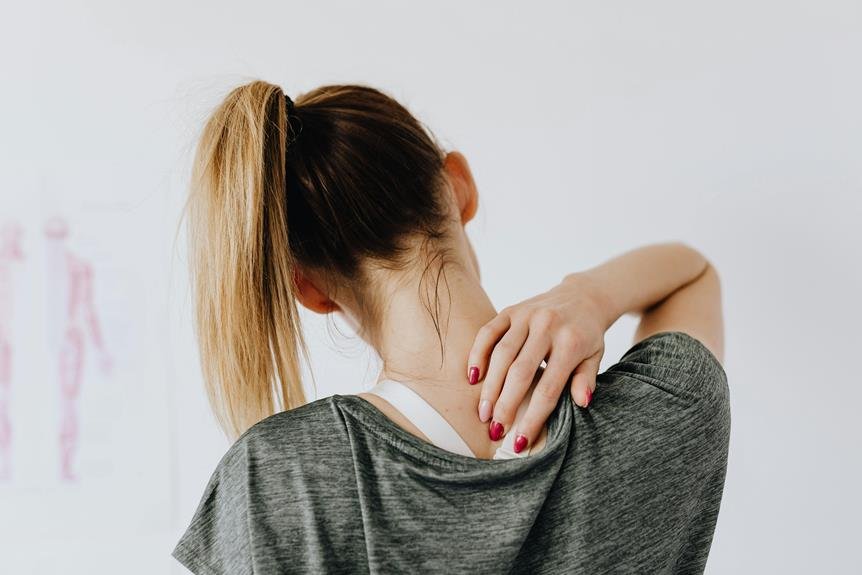Effective Stretches to Relieve Back Pain Within Minutes
Imagine a soothing wave of relief cascading down your spine as you gently stretch and release tension from your back muscles. With just a few minutes of targeted stretches, you can experience immediate relief from nagging back pain that has been holding you back.
Discover the simple yet effective stretches that can make a significant difference in your comfort and mobility, allowing you to move through your day with ease and grace. Each stretch is designed to target specific areas of your back, providing quick and lasting relief that you won't want to miss.
Upper Back Stretch
To stretch your upper back effectively, begin by standing up straight with your feet shoulder-width apart. Raise your arms overhead, clasping your hands together. Slowly lean to one side, holding the stretch for 15-30 seconds, feeling the gentle pull along your upper back. Return to the center and lean to the other side, again holding for 15-30 seconds. This side stretch helps release tension in your upper back muscles.
Next, interlace your fingers in front of you at chest level. Gently push your hands forward, rounding your upper back while tucking your chin to your chest. Hold this position for 15-30 seconds, feeling the stretch along your upper back and between your shoulder blades.
Lastly, clasp your hands behind your back, straightening your arms, and lifting them slightly. Slowly lift your arms upward, feeling the stretch in your upper back and shoulders. Hold for 15-30 seconds, then release. These stretches target your upper back, promoting flexibility and relieving tension.
Cat-Cow Pose
When practicing the Cat-Cow Pose, focus on alignment and mobility to gently stretch your back.
Remember to synchronize your breathing with the movement to enhance the stretch.
These key points can help you maximize the benefits of this pose for relieving back pain.
Alignment and Mobility
Improving your back alignment and mobility can be achieved through practicing the Cat-Cow Pose. This pose involves transitioning between arching your back upward like a stretching cat and dipping it down like a cow's sway, promoting flexibility and strength in your spine.
By moving through these two positions, you engage the muscles along your spine, helping to improve its alignment and mobility. The Cat-Cow Pose also aids in loosening tight muscles in your back, making it a beneficial stretch for relieving tension and discomfort.
Regularly incorporating this pose into your routine can enhance your overall back health, allowing for better posture and reduced back pain. Practice the Cat-Cow Pose to feel the difference in your back's alignment and mobility.
Breathing and Movement
Enhance the benefits of the Cat-Cow Pose by focusing on syncing your breathing with each movement. As you flow through the poses, inhale deeply as you arch your back into the Cow position, allowing your belly to drop towards the floor. Feel the stretch along your spine.
Exhale fully as you transition into the Cat position, rounding your back towards the ceiling and drawing your belly button towards your spine. Coordinate each breath with a smooth, controlled movement, aiming for a seamless flow.
This synchronization of breath and motion can help release tension in your back muscles and improve spinal flexibility. Practice this rhythmic breathing pattern to maximize the therapeutic effects of the Cat-Cow Pose.
Child's Pose
To relieve back pain, perform the Child's Pose stretch regularly. Child's Pose is a simple yet effective yoga stretch that can help alleviate tension in your back.
Start by kneeling on the floor with your big toes touching and knees spread apart. As you exhale, lower your torso down between your thighs and extend your arms in front of you with palms facing down. Rest your forehead on the mat and breathe deeply, focusing on relaxing your back muscles.
This pose gently stretches the spine, hips, and thighs, providing relief to your lower back. Hold the position for 30 seconds to 1 minute while continuing to breathe deeply.
Child's Pose is a restorative stretch that can be done multiple times throughout the day to ease back discomfort. Incorporating this stretch into your daily routine can help improve flexibility and reduce back pain over time.
Seated Forward Fold
Sit on the floor with your legs extended in front of you to prepare for the Seated Forward Fold stretch. This stretch targets the lower back, hamstrings, and shoulders, providing relief from back pain.
Begin by inhaling deeply, lengthening your spine, and as you exhale, hinge at your hips to fold forward. Reach towards your toes or shins, keeping your back straight. You may feel a stretch along the back of your legs and spine. Hold this position for about 30 seconds while breathing deeply. With each exhale, try to deepen the stretch slightly. Remember not to force your body beyond its limits; go only as far as is comfortable for you.
Slowly come back up to a seated position as you inhale. Repeat this stretch a few times to help release tension in your back and improve flexibility. The Seated Forward Fold is a simple yet effective stretch that can be easily incorporated into your daily routine to alleviate back pain.
Spinal Twist
To continue relieving your back pain and enhancing flexibility, the next stretch to focus on is the Spinal Twist. This stretch targets the muscles along your spine, providing relief and improving mobility.
Start by sitting on the floor with your legs extended in front of you. Bend your right knee and place your right foot on the outside of your left knee. Keep your left leg extended.
Inhale and lift your left arm up, then exhale as you twist to the right, placing your left elbow on the outside of your right knee. Use each inhale to lengthen your spine, and each exhale to deepen the twist.
Hold the stretch for 30 seconds to one minute, breathing deeply. This pose helps to release tension in your back and increase flexibility in your spine.
Remember to repeat the stretch on the other side to maintain balance and symmetry in your body.
Cobra Stretch
Let's start by focusing on the proper form demonstration, so you ensure you're getting the most out of the Cobra Stretch.
Understand the numerous benefits this stretch offers your back, such as improving flexibility and relieving tension.
Remember to maintain the stretch for the recommended duration and incorporate it into your routine regularly for optimal results.
Proper Form Demonstration
Assume a prone position with your hands placed under your shoulders to begin the proper form demonstration of the Cobra Stretch. Keep your elbows close to your body and press the tops of your feet into the floor.
Inhale as you slowly lift your chest off the ground, maintaining a slight bend in your elbows. Engage your core muscles and gently draw your shoulder blades back and down. Remember to keep your gaze forward to avoid straining your neck.
Hold the stretch for 15-30 seconds while breathing deeply. To release, exhale as you lower your chest back down to the floor. This stretch helps to strengthen the spine and relieve tension in the lower back.
Benefits of Cobra
After practicing the proper form demonstration of the Cobra Stretch, you'll appreciate the various benefits it offers for your back health. This stretch helps strengthen the muscles along your spine, particularly the lower back muscles.
By doing the Cobra Stretch regularly, you can improve your posture and reduce the risk of back pain caused by weak muscles. Additionally, this stretch can increase flexibility in your spine, promoting better range of motion and preventing stiffness.
The Cobra Stretch also helps relieve tension in the back muscles, making it an effective way to alleviate discomfort after sitting for extended periods. Incorporating this stretch into your routine can contribute to overall back health and well-being.
Duration and Frequency
To maximize the benefits of the Cobra Stretch and prevent injury, it's essential to maintain a consistent duration and frequency in your stretching routine.
When performing the Cobra Stretch, aim to hold the position for about 15-30 seconds initially. As your flexibility improves, gradually increase the duration to 30-60 seconds. For optimal results, repeat the stretch 2-3 times during your stretching session.
To prevent overstretching or straining your muscles, avoid bouncing or forcing the stretch beyond your comfort level.
Consistency is key; aim to incorporate the Cobra Stretch into your routine at least 3-4 times a week. Remember, proper form and regular practice will help alleviate back pain and improve flexibility over time.
Hamstring Stretch
For an effective hamstring stretch that can help alleviate back pain, ensure your form is correct to maximize the benefits. To perform a hamstring stretch, start by lying on your back with both legs extended. Lift one leg towards the ceiling, keeping it as straight as possible. Place your hands behind the thigh or calf – whichever allows you to keep the leg straight without straining. Feel the stretch along the back of your thigh, holding for 15-30 seconds. Remember to breathe deeply throughout the stretch. Switch to the other leg and repeat the process.
Maintaining proper form is crucial during a hamstring stretch to prevent strain. Avoid rounding your back or locking your knee during the stretch. Keep your hips level on the ground to ensure the stretch targets the hamstring effectively. Regularly incorporating this stretch into your routine can help improve flexibility and reduce tension in the lower back. Stretching your hamstrings can also positively impact your posture and overall back health.
Hip Flexor Stretch
To effectively stretch your hip flexors and alleviate back pain, maintain proper form and focus on targeting the muscles along the front of your hips. Begin by assuming a lunge position with one knee on the ground and the other leg bent at a 90-degree angle in front of you. Keep your back straight and gently shift your weight forward until you feel a stretch in the front of your hip. Hold this position for about 30 seconds while breathing deeply. Repeat the stretch on the other side to ensure both hip flexors are equally stretched.
Remember to engage your core muscles to enhance the stretch and avoid overarching your lower back. Regularly incorporating this hip flexor stretch into your routine can help improve flexibility and reduce tension in your hips, which can contribute to alleviating back pain. Make sure to perform this stretch after a workout or as a standalone stretch to keep your hip flexors supple and maintain a healthy back.
Frequently Asked Questions
Can Back Pain Be Completely Cured by Doing These Stretches Regularly?
Regularly doing these stretches can significantly alleviate back pain, but complete cure depends on various factors. Consistent practice, proper posture, and lifestyle adjustments are essential for long-term relief. Consult a healthcare professional for personalized advice.
Are There Any Specific Precautions to Keep in Mind While Performing These Stretches?
When performing stretches for back pain relief, remember to start slowly and listen to your body. Avoid overstretching and stop if you feel sharp pain. It's crucial to maintain proper form to prevent injury.
How Long Should Each Stretch Be Held for Optimal Results?
To achieve optimal results, hold each stretch for at least 15-30 seconds. This duration allows your muscles to relax and lengthen, promoting flexibility and easing tension. Consistency is key, so aim to perform these stretches regularly.
Can These Stretches Be Done by Individuals With Previous Back Injuries or Conditions?
Yes, individuals with previous back injuries or conditions can do these stretches, but it's essential to consult a healthcare provider for personalized advice. Proper modifications and guidance can help you safely benefit from stretching.
Are There Any Alternative Stretches That Can Be Done if Someone Is Unable to Perform the Recommended Ones?
If you struggle with certain stretches due to past injuries or limitations, consider modifications like gentle movements or yoga poses that target the same muscle groups. Always listen to your body and consult a healthcare professional for tailored advice.
Conclusion
In just a few minutes, these effective stretches can help relieve back pain and improve flexibility. Don't let the simplicity of these stretches fool you – they can make a significant difference in how your back feels.
And if you're worried about finding the time to do them, remember that taking care of your body is a priority that can ultimately save you time in the long run by preventing further pain and discomfort.
So take a few minutes out of your day to stretch and feel the benefits!






